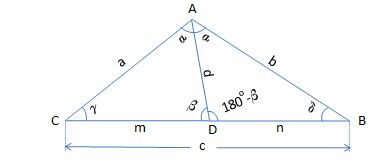A triangle has corners at points A, B, and C. Side AB has a length of #35 #. The distance between the intersection of point A's angle bisector with side BC and point B is #14 #. If side AC has a length of #36 #, what is the length of side BC?
2 Answers
The right answer for this problem is given by @shwetank-m (Shwetank Mauria). In explanation I give an answer for the case in which the segment between point A and the intersection with side BC is 14.
Explanation:
Refer to the figure below

Applying the Law of Sines
to
#a/sin beta=m/sin alpha#
to
#b/sin(180^@-beta)=n/sin alpha# =>#b/sin beta=n/sin alpha#
So
NOTE 1
WHAT IS WRITTEN ABOVE STANDS JUST AS PREAMBLE TO THE ANSWER BY @shwetank-m, WHEN -> N=14
NOTE 2
WHAT IS WRITTEN BELOW IS THE ANSWER WHEN -> D=14
Applying the Law of Cosines to both the aforementioned triangles
#m^2=a^2+d^2-2ad*cos alpha# =>#m^2-a^2-d^2=-2ad*cos alpha#
#n^2=b^2+d^2-2bd*cos alpha# =>#n^2-b^2-d^2=-2bd*cos alpha#
Dividing the two last expressions and substituting
For
#n=sqrt(36/35*(35(36^2+14^2)-36(35^2+14^2))/(36-35))#
#n=sqrt(36/35*(35*1492-36*1421)/1)=sqrt(36/35*1064)=12sqrt(38/5)~=33.08#
=>#m=35/36*12sqrt(38/5)=35/3sqrt(38/5)~=32.16#
So
Explanation:
Using angle bisector theorem (in the figure drawn by Rui D.), we have
Hence
Hence

